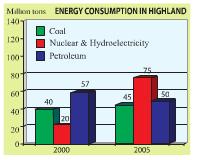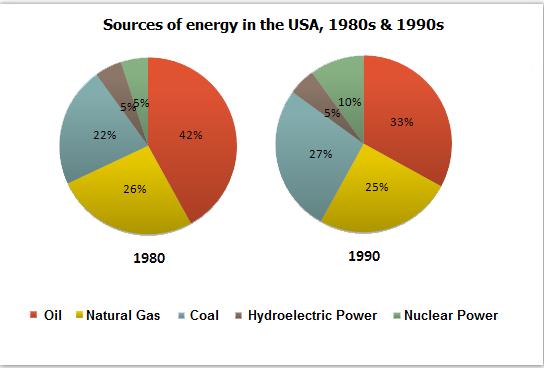Unit 11 lớp 11 Writing - Bài viết Sources of energy
Tóm tắt bài
1. Unit 11 Writing Task 1
Study the chart about energy consumption in Highland in 2000 and fill in the gaps with the information from the chart. (Nghiên cứu biểu đồ về tiêu thụ năng lượng ở Tây Nguyên năm 2000 và điền vào các chỗ trống với các thông tin từ biểu đồ.)
The chart shows the energy consumption in Highland in 2000. As can be seen, the total energy consumption was (1) ______ million tons. Petroleum made up the largest amount of this figure (57 million tons). This was followed by the consumption of (2) _______ (40 million tons). Nuclear & Hydroelectricity made up the (3) ______ amount of energy consumption (20 million tons).
Guide to answer
The chart shows the energy consumption in Highland in 2000. As can be seen, the total energy consumption was 117 million tons. Petroleum made up the largest amount of this figure (57 million tons). This was followed by the consumption of coal (40 million tons). Nuclear & Hydroelectricity made up the smallest amount of energy consumption (20 million tons).
(Biểu đồ thể hiện năng lượng được tiêu thụ ở Tây Nguyên năm 2000. Có thể thấy, tổng số năng lượng được tiêu thụ là 117 triệu tấn. Xăng dầu đã tạo nên khối lượng nhiều nhất trong biểu đồ này (57 triệu tấn). Tiếp đến là sự tiêu thụ năng lượng than đá (40 triệu tấn). Năng lượng hạt nhân và thủy điện chiếm số lượng nhỏ nhất trong tổng số lượng tiêu thụ năng lượng (20 triệu tấn).
2. Unit 11 Writing Task 2
Continue your description of the trends in energy consumption in the year 2005 in Highland. (Tiếp tục mô tả của bạn về các xu hướng tiêu thụ năng lượng trong năm 2005 tại Tây Nguyên).
Guide to answer
The chart presents the energy consumption in Highland in 2005. As can be seen, the total energy consumption was 170 million tons. Nuclear & Hydroelectricity made up the largest amount of this figure (75 million tons). This was followed by the consumption of petroleum (50 million tons). Coal contributed the smallest amount with 45 million tons.
(Biểu đồ biểu thị tiêu thụ năng lượng của Tây Nguyên năm 2005. Có thể thấy rằng, tổng số năng lượng tiêu thụ là 170 triệu tấn. Năng lượng hạt nhân và thủy điện chiếm tỉ lệ lớn nhất trong biểu đồ (75 triệu tấn). Tiếp đến là sự tiêu thụ xăng dầu (50 triệu tấn). Than đá góp phần nhỏ nhất với 45 triệu tấn.
3. Unit 11 Writing Task 3
Describe the chart, using the information from Task 1 and 2. (Mô tả biểu đồ, sử dụng các thông tin từ Bài tập 1 và 2.)
Guide to answer
- Paragraph 1
The chart shows the energy consumption in Highland in 2000 and 2005. As can be seen, the total energy consumption in 2005 was 170 million tons. So it was higher than in 2000 (117 million tons). In 2005, Nuclear and Hydroelectricity made up the largest amount of this figure (75 million tons). This was followed by the consumption of petroleum (50 million tons). Both of them were higher than in 2000. However, coal decreased the amount of the energy consumption (from 57 million tons in 2000 to 50 million tons).
- Paragraph 2
The chart shows the energy consumption in Highland in 2000 and 2005. It's clear that the total energy consumption was 287 millions tons in two years. Petroleum made up the largest amount in 2000 (57 million tons) whereas the petroleum consumption was 50 million in 2005. In 2000 the consumption of coal came the second (40 million tons); however this consumption came the third (45 millions tons) in 2005 after the petroleum consumption. And the consumption of Nuclear and Hydroelectricity was 20 million in 2000. Nevertheless, Nuclear and Hydroelectricity consumption was 75 million tons in 2005. In conclusion, the energy consumption in Highland in 2000 is less than that in 2005.
- Paragraph 3
The chart shows the energy consumption in Highland in 2000 and 2005. As can be seen, there was an upward trend in the consumption of coal, nuclear and hydroelectricity. It was a sharp decrease in the use of petroleum in 2005. The amount of coal used increased by 5 million tons compared with 2000 and the consumption of nuclear & hydroelectricity soared up dramatically by 50 million tons. However, the amount of petroleum consumed in 2005 went down by 50 million tons.
In general, there was a difference in the amount as well as trend of consuming different sources of energy between the two years.
Describe the chart about the sources of energy in USA in 1980s and 1990s
Guide to answer
The pie chart shows the different sources of energy in the USA in two decades – 1980s and 1990s.
The diagram shows that oil was the main energy source for the USA which was used to produce 42% energy in 1980s and 33% in 1990s. Around one-fourth of energy in the USA came from natural gas both in these decades. The usage of nuclear power as a source of energy increases and it produced 10% energy in 1990s which was double than the percentage of energy production from this source in early decade .The production of energy from coal in 1980s was around 22% and it increases by 5% in 1990s. It is very surprising to notice that the production of energy from hydroelectric power remained the same (i.e. 5%) in both decades.
To conclude, oils was the main energy production source in 80s and 90s in the USA and the use of nuclear power as a source of energy doubled.
Bài tập trắc nghiệm Writing Unit 11 Lớp 11
Như vậy là các em đã xem qua bài giảng phần Writing Unit 11 Sources of energy chương trình Tiếng Anh lớp 11 về chủ đề các nguồn năng lượng. Để phát triển kỹ năng viết về đề tài năng lượng trong thiên nhiên mời các em tham gia thực hành Trắc nghiệm Unit 11 lớp 11 Writing
-
Câu 1: Choose the best sentence - a, b, c or d made from the given cues and the sentences which is closest in meaning to the printed one.
the world/ energy resources/ take/ millions of years/ produce/ we/ quickly/ begin/ exhaust/ supplies//
- A. The world's energy resources have taken many millions of years to produce, so we are quickly beginning to exhaust these supplies.
- B. Although the world's energy resources have taken many millions of years to produce, we are quickly beginning to exhaust these supplies.
- C. The world's energy resources have taken many millions of years to produce because we are quickly beginning to exhaust these supplies.
- D. Since the world's energy resources have taken many millions of years to produce, we are quickly beginning to exhaust these supplies.
-
- A. Recently UN committee reported that world's oil and gas supplies, will last about 100 years if they are used carefully.
- B. Recently the UN committee reported that the world's oil and gas supplies would last about 100 years if using carefully.
- C. Recently a UN committee reported that the world's oil and gas supplies would last about 100 years if used carefully.
- D. Recently a UN committee reported that the world's oil and gas supplies would last about 100 years if it was used carefully.
Câu 2 - Câu 7: Xem trắc nghiệm để thi online
Nếu có gì chưa hiểu các em có thể đặt câu hỏi với cộng đồng Tiếng Anh HOCTAP247 ở mục hỏi đáp để được giải đáp nhanh nhất. Sau bài học này các em chuyển qua bài học mới Unit 11 Sources of energy - Language Focus kế tiếp. Chúc các em học tốt!
Bạn có biết?
Tiếng Anh hay Anh Ngữ (English /ˈɪŋɡlɪʃ/ ) là một ngôn ngữ German Tây, được nói từ thời thời Trung cổ tại Anh, ngày nay là lingua franca toàn cầu.Từ English bắt nguồn từ Angle, một trong những bộ tộc German đã di cư đến Anh (chính từ "Angle" lại bắt nguồn từ bán đảo Anglia (Angeln) bên biển Balt)
Nguồn : Wikipedia - Bách khoa toàn thưTâm sự Lớp 11
Lớp 11 - Năm thứ hai ở cấp trung học phổ thông, gần đến năm cuối cấp nên học tập là nhiệm vụ quan trọng nhất. Nghe nhiều đến định hướng sau này rồi học đại học. Ôi nhiều lúc thật là sợ, hoang mang nhưng các em hãy tự tin và tìm dần điều mà mình muốn là trong tương lai nhé!
Nguồn : ADMIN :))Copyright © 2021 HOCTAPSGK


